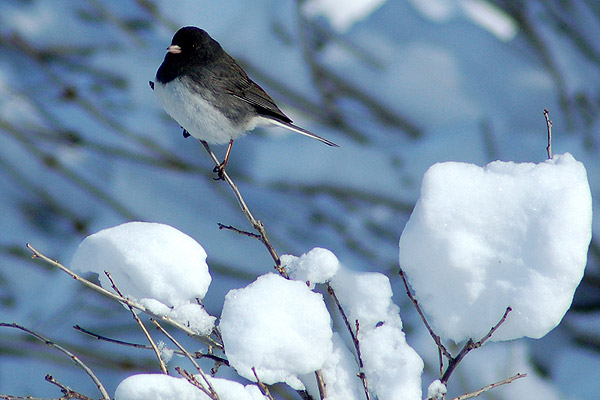
One of my favorite local illustrators, Diana Sudyka, picks the dark-eyed junco as her Bird of 2012. The use of birds in the decorative arts took a hit with the (admittedly well-targeted) Portlandia sketch "Put a Bird on It," but Sudyka, who also does taxidermy at the Field Museum, has a deep interest in ornithology that makes her work more loving than twee. And I share her admiration of juncos. They have always represented winter—which I miss dearly this year—to me, and particularly snowfall.
Which isn't unique to me; they're also commonly known as snowbirds, and were described by Mark Catesby in his 1731 Natural History of Carolina, and Florida as appearing only in the winter in Virginia (where I grew up) and Carolina, "and in snow they are most seen." Probably because the modest-looking little birds aren't particularly notable when they're hopping around on brown grass, but in the snow they pop out. They're also visible because they feed in flocks, along the ground—flocks of 15 to 25, controlling two to three acres. There's a hierarchy to the flocks, but they work in entertainingly fluid units:
The junco flock is an association of birds which is firm in the identity of the individuals associated. . . . In a given small area a single group will be seen and no other. The formation of firm associations and the occupation of definite foraging areas take place at once among the earliest arrivals; it becomes obvious as soon as the first migrants are marked. The late comers are integrated into existing groups. The flock thus formed does not fly about as a unit, however. There appears to be no limit to the size of a foraging group. It may include the whole flock or it may consist of a single bird. The entire flocking procedure is marked by the continual forming and dissolving of groups of unpredictable size consisting of individuals that consort together and are daily visitors at the feeding sites.
I didn't realize it at the time, but this is probably why I loved watching the plain little juncos as a kid. Unlike the more "belligerent" cardinals and blue jays, juncos are constantly at work in teams, specifically while they're foraging—which, because I did all my birdwatching around the feeder, was when I saw them. Other people grew up and looked even closer (PDF):
The sequential organization of scanning for approaching predators and pecking for food was investigated by analyzing films of Yellow-eyed Juncos (Bunco phaeonotus)…. For a given group size, the probability that a bird scans after each peck was found to be a constant. However, this probability decreased as flock size increased. The organization of sequences of scanning and pecking can be depicted as a simple Markov chain where an environmental variable, group size, probabilistically governs the change from pecking to scanning.
The idea being that the more birds, the less frequently they have to look up for any given one to be watching out for predators at any given time. It's no wonder they've been used as examples of Pareto-optimal game theory.
Lots of birds offer interesting behaviors, but few are as easy to appreciate as the junco—particularly because they lend themselves to observing on snowy winter days.
Photograph: dobak (CC by 2.0)



